
240z Honda Wiper Motor Upgrade
The stock windshield wiper motor is notorious for being slow, but an easy replacement exists. Here's how it's done.
 When Datsun began producing the 240z, windshield wipers weren't their highest priority. Brand-new they did a fairly decent job, but after 50 years the wiper motor on my car was worn-out and the lubrication at the pivot joints had turned into a sticky gum. The blades moved so slowly they could barely handle a light mist.
The solution is to replace the stock motor with one from a Honda Civic. All you need to do is drill three new holes and make a small notch on the mounting bracket. The motor doesn't have to be modified. The new wiring is easy.
While the wiper assembly is out of the car, you have two options: just replace the motor (which only takes about an hour), or spend another two hours for a full restoration and you'll have wipers that are better than new, which is what I did.
When Datsun began producing the 240z, windshield wipers weren't their highest priority. Brand-new they did a fairly decent job, but after 50 years the wiper motor on my car was worn-out and the lubrication at the pivot joints had turned into a sticky gum. The blades moved so slowly they could barely handle a light mist.
The solution is to replace the stock motor with one from a Honda Civic. All you need to do is drill three new holes and make a small notch on the mounting bracket. The motor doesn't have to be modified. The new wiring is easy.
While the wiper assembly is out of the car, you have two options: just replace the motor (which only takes about an hour), or spend another two hours for a full restoration and you'll have wipers that are better than new, which is what I did.
 How Much Does It Cost?
Cheaper than you'd believe. I found a used motor on eBay for just $20 (with shipping), and a 12V automotive relay with a pigtailed socket for a mere $5.
If you choose the full restoration route, add about $50 for replacement blades, rubber boots (at the wiper arm pivots), a firewall grommet, some spray cleaner, a little paint, a few e-clips and some grease.
For about $75 total (in 2022) you can have brand-new, faster than stock wipers that will last decades. Is that cheap enough?
How Much Does It Cost?
Cheaper than you'd believe. I found a used motor on eBay for just $20 (with shipping), and a 12V automotive relay with a pigtailed socket for a mere $5.
If you choose the full restoration route, add about $50 for replacement blades, rubber boots (at the wiper arm pivots), a firewall grommet, some spray cleaner, a little paint, a few e-clips and some grease.
For about $75 total (in 2022) you can have brand-new, faster than stock wipers that will last decades. Is that cheap enough?
 That's the Datsun motor on the right and the Honda motor on the left. The mounting patterns are nearly identical.
These are the motors that will work:
Honda Civic CX '92-'95, Del Sol S '93-'97, Del Sol SI '93-'97
Acura Integra GS '97-'01, GSR '94-'01, LS '94-'01, RS '94-'98, Special Edition '95-'96, Type-R '97-'01
That's the Datsun motor on the right and the Honda motor on the left. The mounting patterns are nearly identical.
These are the motors that will work:
Honda Civic CX '92-'95, Del Sol S '93-'97, Del Sol SI '93-'97
Acura Integra GS '97-'01, GSR '94-'01, LS '94-'01, RS '94-'98, Special Edition '95-'96, Type-R '97-'01
 You can get a remanufactured motor (with a warranty) at your local parts store, but make sure the the mounting shaft is flat on two sides. If it doesn't have the flats, and it doesn't have the same mounting pattern, keep looking.
The flats are important because they allow the Datsun crank arm to fit without any cutting or grinding.
You can get a remanufactured motor (with a warranty) at your local parts store, but make sure the the mounting shaft is flat on two sides. If it doesn't have the flats, and it doesn't have the same mounting pattern, keep looking.
The flats are important because they allow the Datsun crank arm to fit without any cutting or grinding.
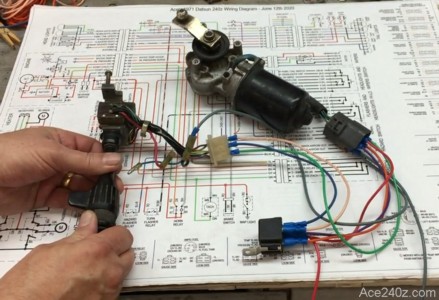 Here's the bench test using the stock 240z switch. Low speed, high speed, and the wiper blades "park". Click on the pic to watch the video.
The "park" function is important. When you turn the wipers off in a modern car, they stop at the bottom of the windshield. If you connect the Honda motor directly to the 240z switch, the blades won't park - you have watch for the blades to get close to the bottom, then turn the switch off and hope for the best.
Fortunately, somebody more clever than me figured out that adding a cheap relay makes it park perfectly.
Here's the bench test using the stock 240z switch. Low speed, high speed, and the wiper blades "park". Click on the pic to watch the video.
The "park" function is important. When you turn the wipers off in a modern car, they stop at the bottom of the windshield. If you connect the Honda motor directly to the 240z switch, the blades won't park - you have watch for the blades to get close to the bottom, then turn the switch off and hope for the best.
Fortunately, somebody more clever than me figured out that adding a cheap relay makes it park perfectly.
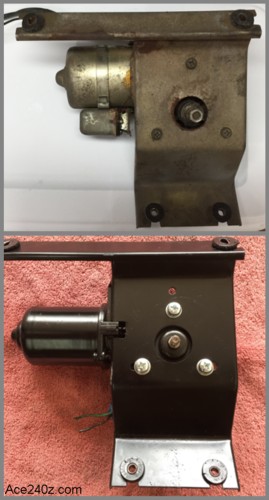 Before starting, disconnect the battery. It's good practice whenever you're doing anything electrical.
Taking the mechanism out is fairly straightforward. First remove the cowl. Unplug the motor, remove the 4 bolts that attach the mounting plate to the car, and remove 3 screws at each of the wiper arm mounts. From there it only takes a little wiggling and twisting to get it out.
Give everything a good cleaning. I'm lucky enough to have a sandblaster but steel wool and sandpaper will do a decent job.
Take the new motor and lightly dab a little grease on the three mounting tabs. Lay the bracket over the motor and center the shaft in the hole (precision isn't required). Lift the bracket back up and turn it over and you'll see three grease marks - that's where you drill the new holes.
With the holes done, lay the bracket over the motor again, line up the holes, then mark where the side of the bracket that needs to be notched to clear part of the motor housing. A hacksaw works fine. I cut the sides of the notch, then bent the remaing "tab" back and forth until it broke off. The same area has a slight lip and part of it needs to be trimmed back. With the cuts made, use a file to smooth the edges.
I gave the bracket and motor a few coats of paint and they look factory-fresh.
That's it for the mechanical modifications.
Before starting, disconnect the battery. It's good practice whenever you're doing anything electrical.
Taking the mechanism out is fairly straightforward. First remove the cowl. Unplug the motor, remove the 4 bolts that attach the mounting plate to the car, and remove 3 screws at each of the wiper arm mounts. From there it only takes a little wiggling and twisting to get it out.
Give everything a good cleaning. I'm lucky enough to have a sandblaster but steel wool and sandpaper will do a decent job.
Take the new motor and lightly dab a little grease on the three mounting tabs. Lay the bracket over the motor and center the shaft in the hole (precision isn't required). Lift the bracket back up and turn it over and you'll see three grease marks - that's where you drill the new holes.
With the holes done, lay the bracket over the motor again, line up the holes, then mark where the side of the bracket that needs to be notched to clear part of the motor housing. A hacksaw works fine. I cut the sides of the notch, then bent the remaing "tab" back and forth until it broke off. The same area has a slight lip and part of it needs to be trimmed back. With the cuts made, use a file to smooth the edges.
I gave the bracket and motor a few coats of paint and they look factory-fresh.
That's it for the mechanical modifications.
 For the full restoration use brake cleaner spray to flush out the old grease and grit from the bronze bushings until they rotate freely. They can be pushed sideways for a deep clean. Repeat as needed. They won't be perfect but a lot better than what you started with.
For the rotating shafts (the parts that move the wiper blades) remove the little clips that hold the shafts in place and they can be pulled out for a good scrub. The little clips will probably get bent or twisted in the process but can be replaced with new ones from your local hardware store.
Like with the motor bracket, use steel wool or sandpaper to clean everything, followed by a few coats of paint.
Grease everything generously when you're done.
For the full restoration use brake cleaner spray to flush out the old grease and grit from the bronze bushings until they rotate freely. They can be pushed sideways for a deep clean. Repeat as needed. They won't be perfect but a lot better than what you started with.
For the rotating shafts (the parts that move the wiper blades) remove the little clips that hold the shafts in place and they can be pulled out for a good scrub. The little clips will probably get bent or twisted in the process but can be replaced with new ones from your local hardware store.
Like with the motor bracket, use steel wool or sandpaper to clean everything, followed by a few coats of paint.
Grease everything generously when you're done.
 This is the connection at the crank arm. It's a weird combination of parts that supposedly act as a "clutch" for the original motor, which had a stop & reverse function when you turned off the wipers. The Honda motor doesn't reverse, but the wipers will work fine without it.
Take it apart and clean the pieces. Inside is a small coil that looks like a spring - if it's broken, don't worry because it doesn't seem to do anything. I threw mine away. Like with the wiper arm shafts, I replaced the original clip with an e-ring.
Give the pieces a good coat of grease.
This is the connection at the crank arm. It's a weird combination of parts that supposedly act as a "clutch" for the original motor, which had a stop & reverse function when you turned off the wipers. The Honda motor doesn't reverse, but the wipers will work fine without it.
Take it apart and clean the pieces. Inside is a small coil that looks like a spring - if it's broken, don't worry because it doesn't seem to do anything. I threw mine away. Like with the wiper arm shafts, I replaced the original clip with an e-ring.
Give the pieces a good coat of grease.
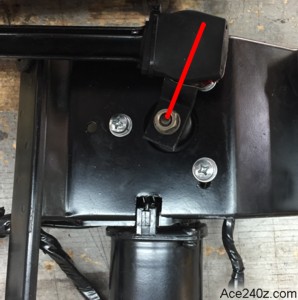 This is VERY important:
When you attach the crank arm to the Honda motor, make sure that it's pointed away from the motor , as show here. If it goes on backwards, your wipers will rotate in the wrong direction. Instead of moving across the glass, they'll move across the cowl and hood, or park in the middle of the windshield, neither of which is good.
I discovered this the hard way and had to pull everything back out, move the crank arm, then stuff it all back into place.
This is VERY important:
When you attach the crank arm to the Honda motor, make sure that it's pointed away from the motor , as show here. If it goes on backwards, your wipers will rotate in the wrong direction. Instead of moving across the glass, they'll move across the cowl and hood, or park in the middle of the windshield, neither of which is good.
I discovered this the hard way and had to pull everything back out, move the crank arm, then stuff it all back into place.
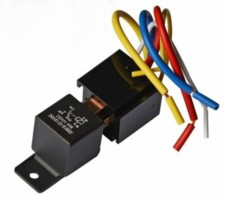 When you buy the 12V relay, get one with a connector and a "pigtail", which is simply a few inches of color-coded wires that are already fastened inside the socket. Using a pigtail means you don't need crimp connectors and the wires themselves are long enough to attach directly to the motor.
It also makes it easy if you ever have replace the relay because you won't have to worry which individual wire goes to which pin.
When you buy the 12V relay, get one with a connector and a "pigtail", which is simply a few inches of color-coded wires that are already fastened inside the socket. Using a pigtail means you don't need crimp connectors and the wires themselves are long enough to attach directly to the motor.
It also makes it easy if you ever have replace the relay because you won't have to worry which individual wire goes to which pin.
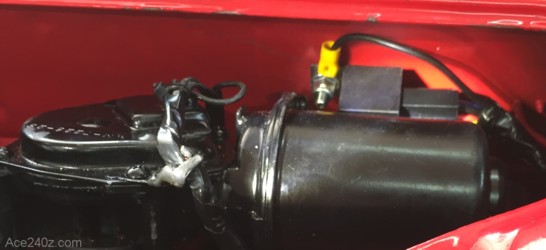 I drilled a hole thru the firewall and bolted the relay up and out of the way.
Because I rewired my car differently than Datsun did, I grounded the motor to the bolt. If you're connecting to the stock wiring harness you won't need to worry about that.
I drilled a hole thru the firewall and bolted the relay up and out of the way.
Because I rewired my car differently than Datsun did, I grounded the motor to the bolt. If you're connecting to the stock wiring harness you won't need to worry about that.
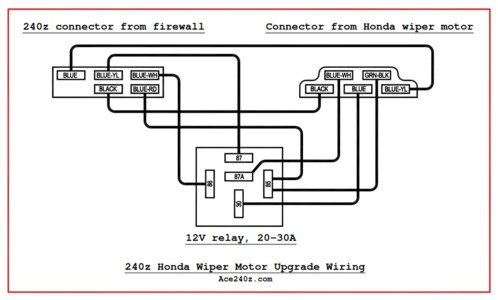 In the past, the most difficult part of the upgrade was changing the wiring but this diagram makes it pretty easy. Click on it for a larger version.
In the past, the most difficult part of the upgrade was changing the wiring but this diagram makes it pretty easy. Click on it for a larger version.
 Here's how the motor harness turned out.
I cut off the Honda plug and soldered all of the wiring except for the four crimped spade lugs. Somewhere in one of my boxes I have an OEM-type connector to match the connector on the car's harness, but I couldn't find it so for now I'll make due with the lugs. You can get brand-new pin connectors from Oregon Motorcycle Parts. As far as I'm concerned, they're the best source. All of the connectors in my car came from them.
I wrapped the wires together with electrical tape, and as I expected it came out pretty lumpy but it doesn't really matter because it won't be seen.
The stock firewall grommet is about $25 plus shipping. I found a generic one that works just as well for $5.
Here's how the motor harness turned out.
I cut off the Honda plug and soldered all of the wiring except for the four crimped spade lugs. Somewhere in one of my boxes I have an OEM-type connector to match the connector on the car's harness, but I couldn't find it so for now I'll make due with the lugs. You can get brand-new pin connectors from Oregon Motorcycle Parts. As far as I'm concerned, they're the best source. All of the connectors in my car came from them.
I wrapped the wires together with electrical tape, and as I expected it came out pretty lumpy but it doesn't really matter because it won't be seen.
The stock firewall grommet is about $25 plus shipping. I found a generic one that works just as well for $5.
 Here's the reward.
I temporarily connected the motor to a switch and put clothespins on the wiper pivots to see how far they turned. Much to my relief, it worked perfectly. The rebuilt mechanism is nice and quiet - no squeaks or rattles.
I'm actually looking forward to my first drive in the rain.
Maybe not.
Here's the reward.
I temporarily connected the motor to a switch and put clothespins on the wiper pivots to see how far they turned. Much to my relief, it worked perfectly. The rebuilt mechanism is nice and quiet - no squeaks or rattles.
I'm actually looking forward to my first drive in the rain.
Maybe not.
 Francisco Gutierrez has a YouTube channel called Pancho's Garage, featuring dozens of episodes showing his restoration of a 240z. I really admire the man because he does great work in a very laid-back manner.
Click on his smiling face to see the episode where he does the wiper motor upgrade and watch how he puts the mechanism back into the car. Afterward, make sure you subscribe, then go back later and watch the rest of his videos. It's time well spent.
Francisco Gutierrez has a YouTube channel called Pancho's Garage, featuring dozens of episodes showing his restoration of a 240z. I really admire the man because he does great work in a very laid-back manner.
Click on his smiling face to see the episode where he does the wiper motor upgrade and watch how he puts the mechanism back into the car. Afterward, make sure you subscribe, then go back later and watch the rest of his videos. It's time well spent.
 When you're done with the upgrade, take a look at the washer fluid hoses. Chances are they're stiff or split and leaking. Does the pump work? Is the tank leaking or filled with crud? Are the nozzles aimed in the right directions?
You probably won't drive your Z when it's snowing, so washer fluid doesn't seem like a big deal but why take the chance? When I owned my '72 it was the only car I had and Colorado winters can be pretty slushy. My new car will stay snug and dry when it snows but I still made sure the washer system works.
When you're done with the upgrade, take a look at the washer fluid hoses. Chances are they're stiff or split and leaking. Does the pump work? Is the tank leaking or filled with crud? Are the nozzles aimed in the right directions?
You probably won't drive your Z when it's snowing, so washer fluid doesn't seem like a big deal but why take the chance? When I owned my '72 it was the only car I had and Colorado winters can be pretty slushy. My new car will stay snug and dry when it snows but I still made sure the washer system works.